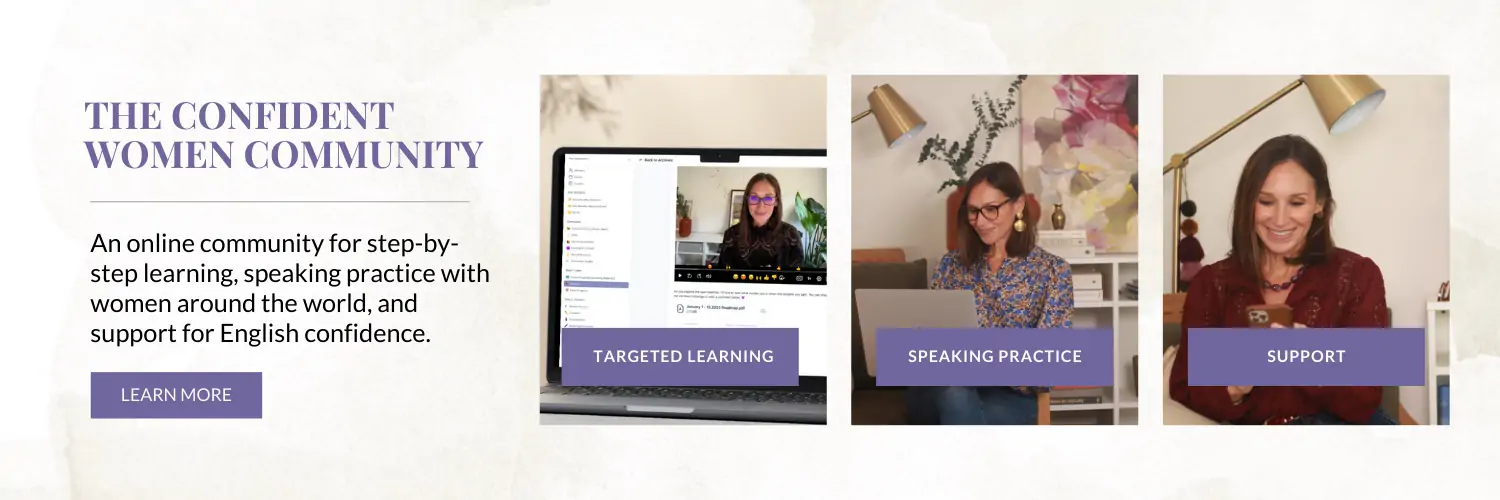#303: The Right Adjective Order | English Grammar Focus [+ FREE Worksheet]

Why is it okay to say:
A: “One of my students recently hosted a fantastic one-hour mindset-focused discussion.”
And not:
B: “One of my students recently hosted a mindset-focused one-hour fantastic discussion…”
I’m using all the exact words. I just changed them around a bit.
If you’re thinking, “I don’t know why, but one of them sounds odd.”
You’re right.
Take a look at those adjectives: fantastic, one-hour, mindset. There is a natural order English speakers use when there is more than one adjective in a sentence.
We call it the Royal Order of Adjectives or the Universal Rule of Adjectives.
When you use the right order, your sentences flow more smoothly.
In this Confident English lesson, you’re going to learn what that order is, how to use it, and how to practice so you always get right.
The Right Adjective Word Order in English
Adjective Order: Quantity + Opinions/Attitudes+ Facts
The general rule of thumb for word order with adjectives before a noun can be broken down into 4 key components:
Determiner + Quantity + Opinions/Attitudes + Facts
- The three lovely Spanish women helped us find the train station.
Let’s take a closer look at these parts and how they work together for smooth, clear sentences.
Part 1: Determiners & Quantity
Although these are not adjectives, they are essential in the correct word order.
Determiners include articles (a, an, the), possessives (my, your, his), and demonstratives (this/that). Determiners will always begin the sentence or place first.
- Your interesting marketing presentation helped to provide a clear picture of our clients’ needs.
- A sensational news story caught my attention this morning.
Then, quantity words follow determiners and are always placed before opinion adjectives.
- These four paint colors suited the energy we wanted in our new home.
Part 2: Opinion/Attitude Adjectives
Following a determiner and/or indication of quantity, we can add adjectives related to personal opinions or attitudes — if appropriate.
Opinion/attitude adjectives indicate someone’s opinion about a noun.
For example, I might say, “This is a lovely green color for the room.” While you might think, “Hmm, it seems like a boring color to me.”
Here’s another example:
- The strange, unfamiliar approach to motivating the team actually worked.
In this case, ‘strange’ and ‘unfamiliar’ might refer to my personal opinion or a general opinion held by the team members.
Part 3: Fact Adjectives
Here’s where it gets interesting! The fact adjectives. There are several categories here, and fact adjectives have their unique order.
Let’s go back to this sentence:
- This is a lovely green color for the room.
Whether or not a color is lovely is debatable. But its color is not. It’s a fact.
Fact adjectives give us details ranging from size to purpose.
There is a specific order to follow to accurately describe a noun and ensure flow when using more than one adjective in a sentence.
- Size
- Physical Quality
- Shape
- Condition
- Age
- Color
- Pattern
- Origin
- Material
- Type/Purpose/Qualifier
Rank 1-7: Appearances
When using adjectives related to the outer appearance of something, we use this order:
Size: Large, small, tiny
Physical quality: Soft, hard, rough
Shape: Round, rectangle, square
Condition: Broken, clean
Age: Old, new, 17th-century
Color: Red, green, white
Pattern: Striped, plaid
Let’s look at this order in practice. Imagine I have a blanket with the following qualities:
- Large
- Old
- Rectangle
- Blue
- Soft
I would say, “I have a large, soft, rectangular, old blue blanket.”
- Large (size)
- Soft (physical quality)
- Rectangular (shape)
- Old (age)
- Blue (color)
Here’s another example with adjectives for a painting:
- Small (size)
- 18th Century
“I have a small 18th-century painting.”
Rank 8-9: Origin & Material
Now that we have the appearance adjectives in place, let’s add on.
Next come adjectives that indicate origin (i.e., nationalities and places of origin) and materials (i.e., brass, wooden, bronze)
For example, if you complimented someone on the brass decor in their living space, they might respond by saying:
- Thank you. I think the old Indian brass decor gives the space a grounded feeling.
- Old (age)
- Indian (origin)
- Brass (material)
Rank 10: Type/Purpose/Qualifier
This final category includes adjectives that answer the question: for what purpose or which type?
For example, a button-down shirt. Button-down highlights the type of shirt.
Or if we’re looking at the artistry of an old jewelry box, jewelry indicates the box’s purpose.
These adjectives are always placed at the end, respectively.
For example, if you were to describe the exact coffee mug you want to buy to a sales associate, you might say:
- I’m looking for a tall blue dishwasher-safe travel mug.
- Tall (physical quality)
- Blue (color)
- Dishwasher-safe (type or feature)
- Travel (purpose)
FREE Adjective Word Order Worksheet
Native English speakers use this word order intuitively, having learned it since infancy.
Thankfully, with a little practice, you can use this word order and get it right every time. That’s why I’ve created a downloadable PDF worksheet for you.
On the worksheet, you’ll find 10 sentence prompts with adjectives you need to organize into the correct order.
Use what you’ve learned in this lesson. Then, check your answers (provided with the worksheet).
You can download the FREE Adjective Word Order Worksheet with the form below the video lesson.
And if you have questions or would like to share your own example sentences using these word pairs, you can share them directly with me in the comments below.
~ Annemarie

Get the Confidence to Say What You Want in English
Follow my 3-step solution to speak English with clarity, fluency, and freedom so you can say what you want with confidence.
You'll also get my Confident English lessons delivered by email every Wednesday and occasional information about available courses. You can unsubscribe any time.
More Like This
Learn English Phrasal Verbs Faster — 5 Minute Routine
Tired of forgetting English phrasal verbs the moment you need them? In this Confident English lesson, you’ll learn a 5-minute daily routine to make phrasal verbs stick—so you can remember them, use them naturally in real conversations, and finally stop second-guessing. Whether you need phrasal verbs for work, everyday conversations, or English speaking practice, this lesson gives you practical steps that fit your real life.
Sound Fluent & Professional: English Phrases for Meetings & Updates
Want to speak English more naturally at work? In this lesson, you’ll learn powerful English phrases for meetings and updates, including business phrasal verbs professionals use every day. Get the vocabulary and expressions you need to give confident project updates, explain delays clearly, and wrap up your message like a pro.
How to Give a Project Update in English at Work
Give a clear project update in English with a concise 3‑step framework. Get the phrases and structure to deliver professional project status reports confidently at work.
Professional Ways to Ask for Help in English (4-Step Formula)
Learn how to ask for help in English at work—without sounding unsure or unprepared. This 4-step formula gives you clear, professional phrases for meetings, emails, and team collaboration.
30+ English Phrases to Compliment Food Naturally and Politely
Learn 30+ natural English phrases for food and how to compliment food in English politely and sincerely. Perfect for dinner parties, eating out, and everyday English conversations.
Describe Food in English: The Ultimate List of Taste & Texture Vocabulary
Learn how to describe food in English with confident, natural vocabulary. Get taste and texture adjectives English speakers use in real conversations, from restaurants to everyday life.
© Copyright 2014-2025 Speak Confident English | Privacy Policy | Terms & Disclaimer | Online Class Policies





